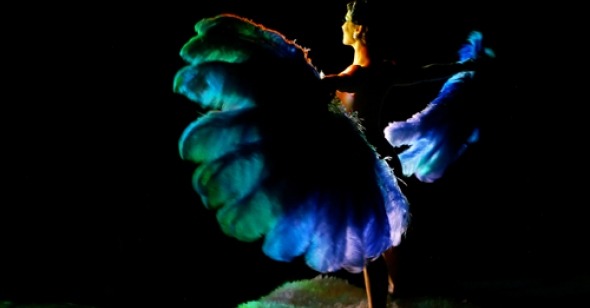Show and Tell
by Chris Wisniewski
A Wink and a Smile
Dir. Dierdre Allen Timmons, U.S., First Run Features
Anyone who’s interested enough in burlesque to sit through Deirdre Allen Timmons’s documentary A Wink and a Smile probably already knows much of what the film has to say about its often misunderstood subject—that burlesque is a different kind of striptease, one that playfully inverts the power dynamics typically implied by the act of stripping. Part of the thrill of burlesque lies in the way its performers turn being-looked-at on its head. Stripping becomes an act of self-empowerment, and the creation of a character or persona can even function as political critique, an investigation of gender roles, racial stereotypes, and social standards of beauty. A Wink and a Smile tells us all this—repeatedly and didactically—through a series of interviews with its principal talking head, a Seattle-based performer named Indigo Blue, who also teaches a training course for aspiring performers at the Seattle Academy of Burlesque.
A Wink and a Smile tries to do two things at once: it uses Indigo’s insights into the Seattle scene, which she elaborates over footage of other burlesque performances, to investigate its subject as an art form, while also following ten students through her six-week course. This ends up being a lot of material to cover in 90 minutes, and Timmons relies mostly on Indigo to explain and contextualize the performances we see and her students’ experiences. The girls speak for themselves too—they talk about their reasons for enrolling in the course (an attempt to overcome stage fright, lingering body issues, the desire to move beyond sexual inhibitions, etc.) and offer brief insights into their lives (one girl reveals she’s a virgin; another, a taxidermist, gives a tour of her freezer, which is stocked with a skinned raccoon and multiple crows), but the film is surprisingly light on footage from the class. At one point, Indigo shows them how to give one another a “pussy check”—it’s pretty much what you’d expect—but beyond that there are few meaningful moments of instruction.
Without a sense of their creative process, it’s difficult to invest in the personal psychological journeys of Indigo’s students. Timmons gives all ten of them more or less equal weight, resulting in too much and too little information at once. Each of them has their “issue” and their corresponding reason for choosing burlesque, but none of them has an arc, or much of an onscreen identity (when Indigo Blue drops a relative bombshell about Miss Hungarian Rhapsody in week five, I must confess that my first reaction was, “Who now?”). Late in the film, one student talks about the new friendships she’s made in the course with a genuine sense of satisfaction, but the moment is most revealing for exposing how little interaction between the women we see in the film. Timmons devotes so much time to her interviews and too little to the girls workshopping their characters, working on their routines, and giving one another feedback.
There’s an awful lot of talking in A Wink and a Smile, even in its musical interludes. The film is divided into six installments, each meant to correspond to a week of the course. These segments open with engaging and occasionally delightful routines by established Seattle performers, but their relation to the content of the course is ambiguous at best. Timmons and her co-editor and cinematographer Peter Waweru, clearly aping Fosse, have an unfortunate tendency towards relentless cutting, and Indigo’s constant voiceover, while informative, can be tiresome and distracting. At its best, burlesque allows for self-transformation through performance, but A Wink and a Smile gives us little of either. It’s all tell and not enough show.
(This article originally appeared in indieWIRE.)
